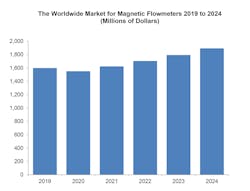Magmeter market expected to approach $1.8 billion this year
The new study released on Nov. 22 also reported that magmeters are running neck and neck with Coriolis meters as revenue leaders in the global flowmeter market, and their market is growing steadily, though not as fast as Coriolis, ultrasonic and vortex flowmeters.
Since less than 8% of the magmeter market is in oil and gas applications, they proved more resilient than other flowmeters during the height of the pandemic and the resulting slump in oil prices. Now, the study reports that magmeters are benefitting as markets recover and the oil and gas industry surges. Even though they don’t measure hydrocarbons, magmeters are used for fracking applications, including measuring water injected into oil and gas wells and water flowing from them for capture, disposal or recycling.
In addition, magmeters are increasingly sought to more closely monitor water supplies, especially as water shortages and climate change highlight water as a precious commodity. In fact, the study adds, thanks to new industry group standards that advise using them for water utility measurement, magmeters are displacing positive displacement and turbine meters in some residential and industrial applications.
“Now is the time for magnetic flowmeters to shine. With climate change and diminishing water supplies, the need to measure water is increasing around the world. The need for more clean water and wastewater treatment is growing with the population,” says Dr. Jesse Yoder, president of Flow Research. “Magmeters are one of the few flowmeter types that can effectively measure wastewater. Multiple liner types make them useful on a wide variety of other liquids. And suppliers continue to bring out technological improvements that make them more versatile and more competitive with other flowmeter types.”
About the Author

Leaders relevant to this article:

